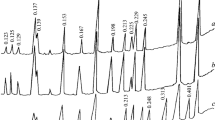Abstract
A model is developed to represent the structure of the mineral component of Troshkovo refractory clays. According to it, a refractory clay particle is an aggregate composed of a crystalline core and an amorphized film around it. Such refractory clays owe their caky character to the colloidal mineral shells that bond the particles into strong aggregates. Mechanical working breaks up the aggregates into a finely divided material and improves the plastic and bonding properties of kaolinite clays.
Similar content being viewed by others
References
N. S. Belostotskaya,Steklo Keram., No. 9, 22–25 (1963).
P. G. Usov and É. A. Guber, in:Trudy Tomsk. Khim. Obshch., (1966), pp. 36–42.
É. A. Guber,Material Composition of Capping Loams in the Tomsk Region, Author’s Abstract of Candidate’s Thesis [in Russian], Tomsk (1965).
M. F. Vikulova,Methodological Guide for Petrographic Study of Clays [in Russian], Gosgeoltekhizdat, Moscow (1957).
Author information
Authors and Affiliations
Additional information
Translated from Steklo i Keramika, No. 11, pp. 23–26, November, 1997.
Rights and permissions
About this article
Cite this article
Vakalova, T.V. Caky character and plasticity of refractory clays from the Troshkovo deposit. Glass Ceram 54, 357–360 (1997). https://doi.org/10.1007/BF02768182
Issue Date:
DOI: https://doi.org/10.1007/BF02768182




